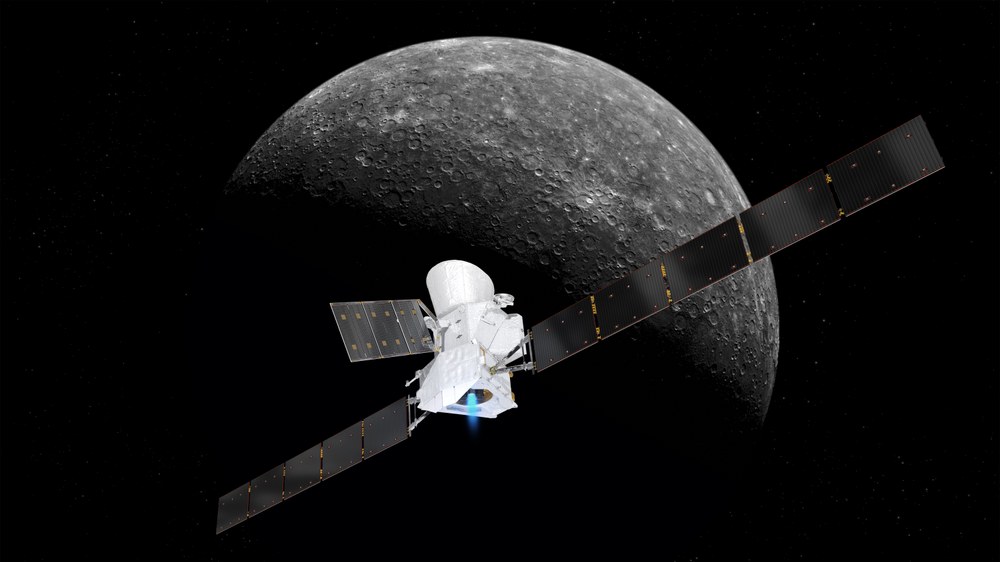BepiColombo

After its successful launch in October 2018 from Europe's Spaceport in Kourou, French Guiana, ESA's BepiColombomission is currently on its nominal 7-year journey to the planet closest to the Sun. The interplanetary cruise will include nine flybys for gravitational assists: one at Earth, two at Venus and six at Mercury. The Earth flyby and the first Venus flyby took place in April and October 2020, the second Venus flyby in August 2021 followed by the first Mercury flyby in November 2021, the second in June 2022 and the third in June 2023. Several instruments, including the MERTIS spectrometer contributed by DLR-PF, were able to collect data during some of the flybys. Two more Mercury flybys will follow in 2024, and the sixth and final maneuver will occur on January 9, 2025. On December 5, 2024, the spacecraft will be directed into Mercury orbit. Once in Mercury orbit, BepiColombo’s carrier spacecraft will release two orbiters, ESA’s Mercury Planetary Orbiter (MPO), and JAXA’s Mercury Magnetospheric Orbiter (MMO), for a one-year nominal science mission. The MPO will study the surface, interior, exosphere, and magnetosphere of the planet using a suite of 11 instruments. Two of the instruments, the BepiColombo Laser Altimeter BELA and the Mercury Thermal Infrared Spectrometer MERTIS were built and will be operated under the responsibility of DLR's Institute of Planetary Research.
BELA is a laser altimeter that will measure the planet's topography globally, including the first altitude measurements of the Southern Hemisphere. From distances of up to 1400 kilometers from Mercury's surface, laser pulses will be made ten times per second to measure distance. Combined with gravity field data, this gives insight into the processes that have shaped the planet’s crust and surface features. Measurements of Mercury’s tidal deformation would further provide evidence for the presence of a liquid outer core and could constrain the size of a solid inner core. Unfortunately, BELA cannot be operated in full science mode during cruise. In 2022 two regular BELA checkouts were performed in May and November, respectively and the functionality of the instrument was successfully verified.
MERTIS will study the mineralogy and temperature distribution of Mercury’s surface in unprecedented detail. MERTIS scientific objectives are the study of Mercury’s surface composition, the identification of rock-forming minerals, the mapping of surface mineralogy and the study of surface temperature and thermal inertia. MERTIS aims to capture data on the mineralogy whereas the radiometer surveys the thermal inertia of the planet. The MERTIS instrument operated successfully during the flyby of the Earth-Moon system on 10 April 2020 and the the two flybys of Venus on 15 October 2020 and 10 August 2021. MERTIS obtained a total of 1.2 million spectra of the Moon from a distance of more than 700,000 km. Venus observations started for the first flyby at a distance of more than 1.3 million km and in total more than 3 million spectra were obtained. During the second Venus flyby MERTIS obtained data at the time of the closest approach to the planet at a distance range from 800 to 1000 km. For reference at Mercury MERTIS will observe the planet from distances between 400 and 1500 km. The data of the flybys combined with the Near-Earth commissioning data show that MERTIS performance exceeds requirements. In 2022 MERTIS performed regular checkout verifiying the instrument performance and testing routines for planned observations of Mercury during the flyby at the end of 2023 and in 2024.
Hardware Participation of the DLR Institute of Planetary Research
- BELA (BepiColombo Laser Altimeter)
Co-PI: Hauke Hussmann - MERTIS (MErcury Radiometer and Thermal Infrared Spectrometer)
Co-PI: Jörn Helbert
Scientific Participation of the DLR Institute of Planetary Research
- BELA (BepiColombo Laser Altimeter)
- MERTIS (MErcury Radiometer and Thermal Infrared Spectometer)
- SIMBIO-SYS (Spectrometer and Imaging for MPO BepiColombo Integrated Observatory SYStem)
- MORE (Mercury Orbiter Radio-science Experiment)
Further DLR Participation
Institut für Optische Sensorsysteme
